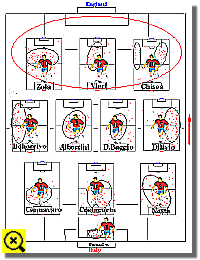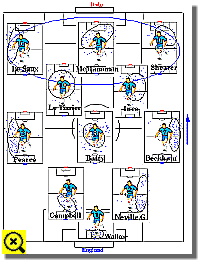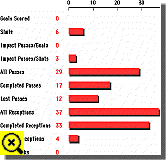
Computer software opens up new worlds. Article that appeared in the October 1995 issue of FIFA Magazine.
Previous Match Analysis
Malaysia 97 Final:
Uruguay v Argentina
South America's First U-17 Title:
Brazil v Ghana
1998 FIFA World Cup Qualifying:
Italy v England
1998 CONCACAF Gold Cup Final:
USA v Mexico
World Cup 98 Qualifications:
Japan v Iran


|
Italy vs England Overview Discover the world of computerised match analysis software and learn all about the performances and styles of teams and players. The match analysis software can provide a concise, unbiased evaluation of team players and opponents during the game played. This game analysis provides a deeper understanding and a unique view beyond what can be seen either in person at the game or viewed on video afterwards. For example, it sometimes happens that the unobtrusive player proves to be the most productive performer on the team. Often mistaken for a plodder, this is the player who drags their side back from the brink of defeat in the nick of time. Now, this match analysis software gives this player the recognition he deserves.
To demonstrate to you just how tough it was, SoftSport's Second Look match analysis software was applied to dissect the tactics used in the two qualifying games between Italy and England. The first game at Wembley ended in a 1-0 victory for Italy and the second game ended in a 0-0 tie in Italy. The data shows exactly where players were throughout the 90 minutes. And while coaches may say they played 4:3:3 or 4:4:2, the computerized analysis data shows what actually happened.
Analysis of the Match 
Line-ups are dynamic and change with the circumstances of the game. SecondLook revealed that from where the Italian players spent most of their time during the game in England their system is best described as 6:2:2. Although it could possibly be construed as 4:4:2. At times Italy had nine players in the defensive 1/3 of the field and throughout the 90 minutes only Zola and Casiraghi foraged in midfield and on the attack. Examine the charts of where the Italians touched the ball and you will see that even Casiraghi came back to help defend.
The Players
Conclusion Looking ahead to France, does that mean that coaches will go into the game thinking "defense first"?, Will playing "not to lose" be enough for teams to qualify for the second round now that only two teams from each group move forward? Or, more importantly, will the coaches of teams such as England and Italy learn from the qualifying games how to score more goals? In essence, all of the games in France will be away games - except for the host nation of course. So will the prevailing tactics be ofensive or defensive? Your regarding Coaches Corner are welcome. A P P E N D I X Italy's Goal - Trace Back
Each oval around the player represents the player's playing zone.
Each oval around the player represents the player's playing zone.
Each oval around the player represents the player's playing zone.
Each oval around the player represents the player's playing zone.
Copyright © 1994-97 FIFA. All rights reserved. |
||||||||||||||||||||||||||||||||||||||||||||||||||||||||||||||||||||||||||||||||||


















